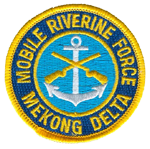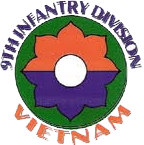Army-Navy Mobile Riverine Force
By early 1965 the Vietnam War was escalating at a rapid pace. Marines were making beach landings, Army air mobile forces were put into action and it was determined by the higher ups that something serious needed to be done to slow down the enemy supply routes in the South China Sea, Gulf of Tonkin and the Gulf of Siam.
In March of 1965 a coastal interdiction force named Operation Market Time was put into place. Working corporately with the Vietnamese Navy (VNN), the U.S. Navy and U.S. Coast Guard launched the new tactic with immediate success. In July of 1965 the Coastal Surveillance Force/Task Force 115 was activated and took command of all coastal interdiction.
From the onset North Vietnamese and Viet Cong vessels were being encountered and sunk by the joint forces. It became obvious to the enemy that they needed to switch strategy. This led to an increased movement of arms and supplies via inland waterways.
As the movement of enemy supplies increased on the inland rivers and canals the U.S. Navy formed Task Force 116. The official name became the River Patrol Force. The primary vessel used was the Patrol Boat River (PBR). The PBR sailors had their hands full from the beginning. As new river divisions were formed the frequency of contact increased. Operation Game Warden took it to the enemy with fierce determination.
Commander Naval Forces Vietnam, realizing that more manpower was needed, decided to expand operations. In early 1967 Mobile Riverine Force/Task Force 117 was formed. The plan was to combine U.S. naval and army forces in an attempt to thwart the enemies efforts. The Navy Mobile Riverine Force and Army 2nd Brigade of the 9th Infantry Division were soon to become partners in the war effort. Later the Army 3rd Brigade joined the alliance.
The Mobile Riverine Force concept was based upon tactics from two previous wars. The U.S. Civil War saw the first ever ironclad vessels pitted against one another. Until then all hulls were wooden structures. The U.S.S. Monitor, a Union vessel, and the U.S.S. Merrimack, a Confederate States vessel, made history while battling one another on March 9, 1862. Ironically, the Union Navy had purposely sunk the U.S.S. Merrimack, it’s own vessel at the time, early in the war in order to keep it out of confederate hands. The confederates were resilient, though, and raised the vessel, refitted it and she played a major role in naval history. These were but two of the many ironclad vessels used during that era. The United States never built another wooden battleship.
During the Indochina War the French Navy successfully utilized riverine assault craft against Viet Minh forces between 1946 and 1954. They were called dinassauts. When the U.S. Mobile Riverine Force arrived in 1967 many of the older French craft were still being used by the South Vietnamese Naval Forces.
The Mobile Riverine Force began operations in January 1967. River Assault Squadron 9 was soon joined by River Assault Squadron 11. The assault craft were mainly formed from older Landing Craft Mechanized (LCM) 6 hulls. Most were 50-55 feet in length and propelled by twin V-6 engines. The styles included: 1) A Monitor boasting a 40MM cannon on it’s bow. Later the Program V monitors had 105 howitzer mounts. 2) A flame boat called a Zippo that could spray napalm hundreds of feet. 3) An Armored Troop Carrier, dubbed the “Tango”, that was used to ferry infantry troops from one location to another. It also had a miniature helicopter pad. 4) A Command and Communication Boat that provided logistics for each operation. 5) An Assault Support Patrol Boat that was equipped with sonar and V-12 engines for minesweeping purposes. 6) A Tango boat that was outfitted with high pressure water cannons to dispose of enemy bunkers. All of these craft were heavily armed with 20 MM cannons, Mark-19 Grenade Launchers, .50 and .30 caliber machine guns, small arms and various other weapons.
The Viet Cong and North Vietnamese soldiers were initially surprised by the efforts of the joint Mobile Riverine Force, but they soon began developing resistance tactics. The September 1967 battle on the Ba Rai River turned out to be a prime example. During the 4 hour battle, in which half of the boats were hit by heavy enemy fire, 3 Navy men were killed and 77 wounded. The enemy suffered 173 casualties.
The Mobile Riverine Force played a key role in saving the Mekong Delta from enemy control during the 1968 TET Offensive. By June of 1968 River Assault Squadrons 13 and 15 had joined the force. Two Mobile Riverine Bases, made up of various support ships and craft, were in place along the main rivers to support the infantry and riverine craft on a daily basis. Dong Tam, an Army/Navy base, was built from scratch to house additional support elements of the Mobile Riverine Force.
Battles were taking place all over the III and IV Corps Regions. The areas closer to Saigon were protected by River Assault Squadrons 9 and 11. More southern combat regions were covered by River Assault Squadrons 13 and 15 in conjunction with Vietnamese Marines (VNMC), Vietnamese Army (ARVN) and Regional/Popular Forces (RF/PF).
Operation Giant Slingshot and Operation SEALORDS were two of the larger thrusts to interdict enemy forces and supplies. Many other smaller Task Groups, Task Units, and Task Elements met the enemy on his own turf. At one point Time Magazine reported a casualty rate amongst Mobile Riverine Forces as high as 70%. The Viet Cong and North Vietnamese were suffering much higher rates of attrition.
As the U.S. began to withdraw from Vietnam President Nixon instituted the Vietnamization Program. In early to mid 1969 the Mobile Riverine Force turned River Assault Squadrons 9 and 11 over to the Vietnamese Navy (VNN). On August 25, 1969 the joint Army-Navy Mobile Riverine Force was officially disbanded. U.S. Navy personnel would continue to fight the remaining boats in various capacities until December 1970 when the last riverine craft was turned over to the VNN.
During their watch the sailors and soldiers of the Mobile Riverine Force were awarded scores of personal awards for valor as well as many Presidential Unit Citations, Valorous Unit Awards, Navy Unit Commendations, Meritorious Unit Commendations, Vietnamese Gallantry Crosses and Vietnamese Civil Action Medals. Many sailors and soldiers paid the ultimate sacrifice and hundreds were wounded. The Army-Navy Mobile Riverine Force has earned it’s proud place in the annals of United States military history.
Michael A. Harris
3-29-02


